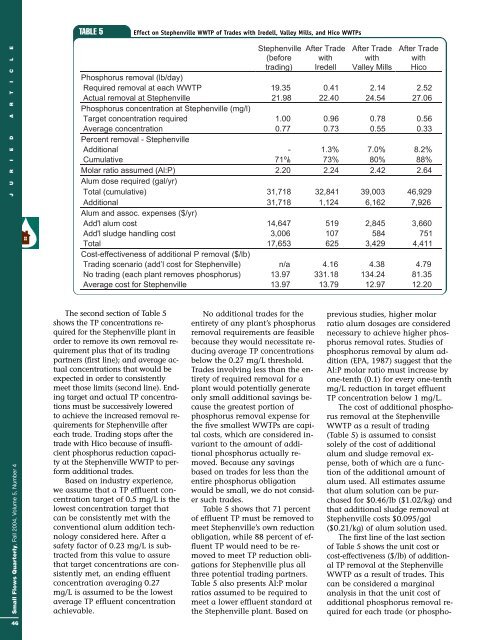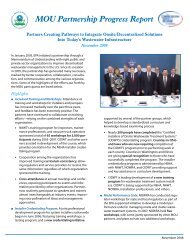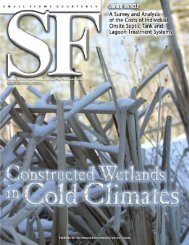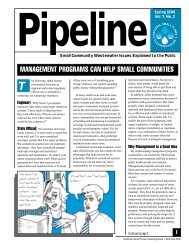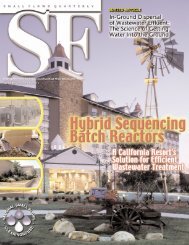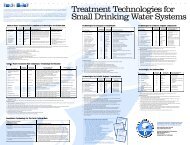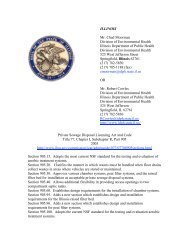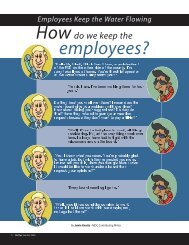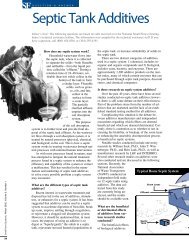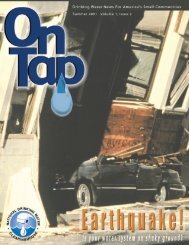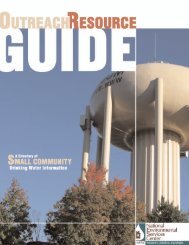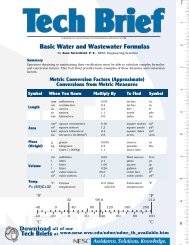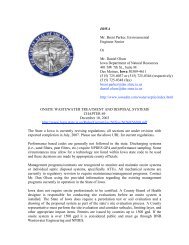Download - National Environmental Services Center - West Virginia ...
Download - National Environmental Services Center - West Virginia ...
Download - National Environmental Services Center - West Virginia ...
You also want an ePaper? Increase the reach of your titles
YUMPU automatically turns print PDFs into web optimized ePapers that Google loves.
TABLE 5<br />
Effect on Stephenville WWTP of Trades with Iredell, Valley Mills, and Hico WWTPs<br />
Small Flows Quarterly, Fall 2004, Volume 5, Number 4<br />
J U R I E D A R T I C L E<br />
The second section of Table 5<br />
shows the TP concentrations required<br />
for the Stephenville plant in<br />
order to remove its own removal requirement<br />
plus that of its trading<br />
partners (first line); and average actual<br />
concentrations that would be<br />
expected in order to consistently<br />
meet those limits (second line). Ending<br />
target and actual TP concentrations<br />
must be successively lowered<br />
to achieve the increased removal requirements<br />
for Stephenville after<br />
each trade. Trading stops after the<br />
trade with Hico because of insufficient<br />
phosphorus reduction capacity<br />
at the Stephenville WWTP to perform<br />
additional trades.<br />
Based on industry experience,<br />
we assume that a TP effluent concentration<br />
target of 0.5 mg/L is the<br />
lowest concentration target that<br />
can be consistently met with the<br />
conventional alum addition technology<br />
considered here. After a<br />
safety factor of 0.23 mg/L is subtracted<br />
from this value to assure<br />
that target concentrations are consistently<br />
met, an ending effluent<br />
concentration averaging 0.27<br />
mg/L is assumed to be the lowest<br />
average TP effluent concentration<br />
achievable.<br />
No additional trades for the<br />
entirety of any plant’s phosphorus<br />
removal requirements are feasible<br />
because they would necessitate reducing<br />
average TP concentrations<br />
below the 0.27 mg/L threshold.<br />
Trades involving less than the entirety<br />
of required removal for a<br />
plant would potentially generate<br />
only small additional savings because<br />
the greatest portion of<br />
phosphorus removal expense for<br />
the five smallest WWTPs are capital<br />
costs, which are considered invariant<br />
to the amount of additional<br />
phosphorus actually removed.<br />
Because any savings<br />
based on trades for less than the<br />
entire phosphorus obligation<br />
would be small, we do not consider<br />
such trades.<br />
Table 5 shows that 71 percent<br />
of effluent TP must be removed to<br />
meet Stephenville’s own reduction<br />
obligation, while 88 percent of effluent<br />
TP would need to be removed<br />
to meet TP reduction obligations<br />
for Stephenville plus all<br />
three potential trading partners.<br />
Table 5 also presents Al:P molar<br />
ratios assumed to be required to<br />
meet a lower effluent standard at<br />
the Stephenville plant. Based on<br />
previous studies, higher molar<br />
ratio alum dosages are considered<br />
necessary to achieve higher phosphorus<br />
removal rates. Studies of<br />
phosphorus removal by alum addition<br />
(EPA, 1987) suggest that the<br />
Al:P molar ratio must increase by<br />
one-tenth (0.1) for every one-tenth<br />
mg/L reduction in target effluent<br />
TP concentration below 1 mg/L.<br />
The cost of additional phosphorus<br />
removal at the Stephenville<br />
WWTP as a result of trading<br />
(Table 5) is assumed to consist<br />
solely of the cost of additional<br />
alum and sludge removal expense,<br />
both of which are a function<br />
of the additional amount of<br />
alum used. All estimates assume<br />
that alum solution can be purchased<br />
for $0.46/lb ($1.02/kg) and<br />
that additional sludge removal at<br />
Stephenville costs $0.095/gal<br />
($0.21/kg) of alum solution used.<br />
The first line of the last section<br />
of Table 5 shows the unit cost or<br />
cost-effectiveness ($/lb) of additional<br />
TP removal at the Stephenville<br />
WWTP as a result of trades. This<br />
can be considered a marginal<br />
analysis in that the unit cost of<br />
additional phosphorus removal required<br />
for each trade (or phospho-<br />
46


